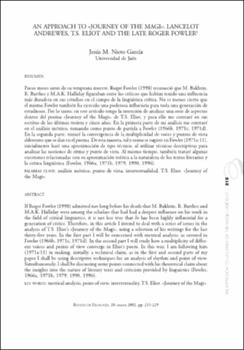An Approach to "Journey of the Magi": Lancelot Andrewes, T. S. Eliot and the late Roger Fowler
Author
Nieto García, Jesús ManuelDate
2002Abstract
Pocos meses antes de su temprana muerte, Roger Fowler (1998) reconoció que M. Bakhtin,
R. Barthes y M.A.K. Halliday figuraban entre los críticos que habían tenido una influencia
más duradera en sus estudios en el campo de la lingüística crítica. No es menos cierto que
el mismo Fowler también ha ejercido una poderosa influencia para toda una generación de
estudiosos. Por lo tanto, en este artículo tengo la intención de analizar una serie de aspectos
dentro del poema «Journey of the Magi», de T.S. Eliot, y para ello me centraré en sus
escritos de los últimos treinta y cinco años. En la primera parte de mi análisis me centraré
en el análisis métrico, tomando como punto de partida a Fowler (1966b, 1971c, 1971d).
En la segunda parte, trataré la convergencia de la multiplicidad de voces y puntos de vista
diferentes que se dan en el poema. De esta manera, tal y como se sugiere en Fowler (1971a:11),
inicialmente haré una aproximación de tipo técnico, al utilizar técnicas descriptivas para
analizar las nociones de ritmo y punto de vista. Al mismo tiempo, también trataré algunas
cuestiones relacionadas con su aproximación teórica a la naturaleza de los textos literarios y
la crítica lingüística (Fowler, 1966a, 1971b, 1979, 1990, 1996). If Roger Fowler (1998) admitted not long before his death that M. Bakhtin, R. Barthes and
M.A.K. Halliday were among the scholars that had had a deepest influence on his work in
the field of critical linguistics, it is not less true that he has been highly influential for a
generation of critics. Therefore, in this article I intend to deal with a series of issues in the
analysis of T.S. Eliot’s «Journey of the Magi», using a selection of his writings for the last
thirty-five years. In the first part I will be concerned with metrical analysis, as covered in
Fowler (1966b, 1971c, 1971d). In the second part I will study how a multiplicity of different
voices and points of view converge in Eliot’s poem. In this way, I am following him
(1971a:11) in making, initially, a technical claim, as in the first and second parts of my
paper I shall be using descriptive techniques for an analysis of rhythm and point of view.
Simultaneously, I shall be discussing some points connected with his theoretical claim about
the insights into the nature of literary texts and criticism provided by linguistics (Fowler,
1966a, 1971b, 1979, 1990, 1996).





